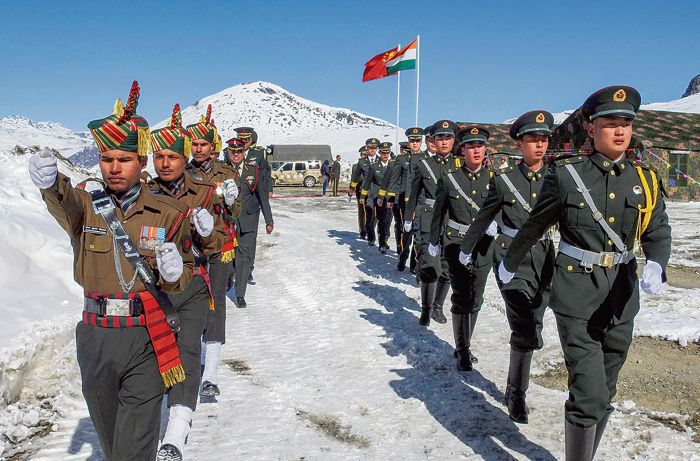The PLA is continuing with its ‘nibbling’ tactics, evident from the clash with graziers in Chushul.


MEDIA reports about China moving its nationals into villages along the Line of Actual Control (LAC) and Ladakhi herders confronting soldiers of the Chinese People’s Liberation Army (PLA) sum up the state of affairs on the frontline. The prolonged standoff in Ladakh remains a security concern, even as it has been reported that Indian and Chinese troops were involved in skirmishes between September 2021 and November 2022.
Last month, Chief of Army Staff Gen Manoj Pande described the situation on the LAC as ‘stable but sensitive’. The impasse is entirely of China’s making, consequent to the PLA undertaking incursions in May 2020 in Pangong Tso, Gogra-Hot Springs, Galwan and Depsang areas of Ladakh so as to unilaterally change the status of the LAC. Considering the magnitude of the intrusions, it was obvious that the operation was approved by the Central Military Commission, China’s apex defence body headed by the President. The PLA’s hostile action, violating a series of bilateral border agreements, had taken India’s politico-military leadership by surprise, given that the strategic guidance mechanism put in place by PM Narendra Modi and President Xi Jinping had apparently been working well.
The Indian Army’s swift counter-deployment was aimed at restoring the status quo. However, having gained initial advantage, the PLA was in no mood to budge. It was only after India secured the Kailash Range in August 2020 that forced the Chinese to negotiate. Thereon, as a sequel to 20 rounds of military commanders talks alongside politico-diplomatic initiatives, the opposing forces have disengaged in three of the five contested areas; the Chinese have refused to yield ground in Depsang and Demchok.
The process of disengagement has come with new protocols, wherein erstwhile patrolling points (PPs) on the LAC — depicting the extent of patrolling limits — have now been replaced by ‘buffer zones’. Of the 65 PPs astride the LAC in Ladakh, 26 are now inaccessible, an aspect which has been flagged by the local police authorities in Leh during security review meetings. In the absence of de-escalation, the ground situation remains tense, with both sides deploying around 50,000 troops each. Clashes between the Indian Army and the PLA in the eastern sector (Arunachal-Tibet border) came to light when the citations for gallantry awards were read out during the investiture ceremonies held recently.
The PLA is continuing with its ‘nibbling’ tactics, evident from the clash with graziers in Kakjung area of Nyoma in Chushul. The herders were intercepted at the PPs 35-37 in Dungti village by over a dozen PLA personnel, escorted by three armoured vehicles. Chushul councillor Konchok Stanzin, who posted a video of the incident on social media, said the livelihood of locals had been taken away in the name of creating ‘buffer zones’.
The PLA’s grand design can be gauged from the massive military infrastructure development along the LAC in recent years. Major projects include twin bridges over Pangong Tso; a second national highway, G 695, through Aksai Chin; and the Nyingchi-Lhasa-Xigaze railway line (planned to be further extended to Gyirong and Burang, close to the Nepalese border). All airports in Tibet have been upgraded.
Further, the PLA is in the process of transforming Tibet into a formidable defence shield, in keeping with the directions of President Xi. To this end, 628 ‘well-off villages’ (Xiaokang) have been constructed; around a third of these are located in close proximity to the LAC. These dwellings are likely to act as the first line of defence; understood to be ‘dual use infrastructure’ — for both civil and military purposes.
Additionally, the ‘New Defence Law’ was enacted in 2021 to ensure better ‘civil-military fusion’. A year later, the ‘Border Defence Law’ was passed; it entails marking the borders with a view to consolidating control over the occupied areas. Giving Mandarin names to places in Arunachal Pradesh (Zangnan) and the Indian Ocean Region is part of China’s ‘Three Warfare Strategy’ to legitimise its claims.
China has deliberately downplayed the border issue to safeguard its economic interests and international image. As per China’s Charge d’Affaires Ma Jia, trade between the two countries reached a record $136.2 billion in 2023 (it was $135.8 billion in 2022, with a deficit of $73 billion in China’s favour). It is evident that Beijing has succeeded in delinking the border issue from economic ties despite New Delhi’s stance that the bilateral relations cannot be normal unless the boundary dispute is resolved.
Ladakh is faced with a two-front threat — Pakistan on the west and China on the east. Hence, a well-defined border defence strategy is an imperative — it is no longer just an option. The current mechanism of border management, with the Indo-Tibetan Border Police as the lead agency under the Ministry of Home Affairs, merits a holistic review. Our Vibrant Villages Programme must be integrated into the overall security plans. As civil-military cooperation is the key to effective defence, the grievances of the Ladakhi people must be addressed on priority. Political instability in this vulnerable border region will seriously impinge on national security.
Given the Dragon’s expansionist push, it is apparent that the situation on the LAC will remain sensitive. As de-escalation is unlikely in the near future, periodic skirmishes are set to be the new normal — a semblance of the ‘armed co-existence’ scenario of the early 1960s. At the strategic level, the situation may be perceived to be stable as the PLA is unlikely to undertake major operations, having already achieved its aim. However, China will continue to upgrade its military capabilities to maintain its operational edge and keep up the pressure on the border to serve its geopolitical interests.
